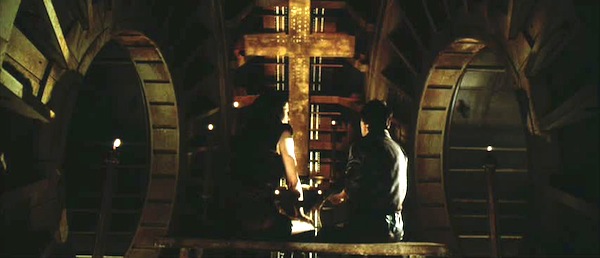
The new summer issue of The Mockingbird contains a bunch of lists of recommendations and favorites (and heresies). This is one of them.
For those looking for some popcorn-worthy viewing (and re-viewing) this summer, a few interstellar picks with surprisingly relevant themes:
1. Serenity (2005). In which Joss Whedon poses big questions and proves once again that he understands original sin better than anyone in the business. Chiwetel Ejiofor makes a fabulous villain, and major kudos go to Whedon for including Shepherd Book in the action, a clergyperson with the kind of conviction, vitality, and heart that one seldom sees on screen anymore. First rule of flying? Duh! Love.
2. Solaris (1972). Not to be confused with Soderbergh-Clooney’s tedious remake, this fairly low-tech Soviet science-fiction film has a conclusion that takes a religious viewer almost completely by surprise. The director, Andrei Tarkovsky, stages a visual re-enactment of Rembrandt’s painting of the Prodigal Son which is deeply and wonderfully emotional. Quite cerebral up to that point, Solaris suddenly goes right through the roof/airlock.
3. Dante 01 (2008). Nothing that French filmmaker Marc Caro had (co-)directed up to this point (Amelie, Delicatessen, City of Lost Children) could have possibly prepared his audience for what has to be the most Christological science fiction film ever made. In fact, the allegorical element may be too on-the-nose for some. Yet what it lacks in subtlety, it more than makes up for in left-field audacity (and grungy, intergalactic criminel). The climatic zero-gravity crucifixion, below, has to be seen to be believed. I’d love to meet the person who green-lit this one.
4. Star Trek 2: The Wrath of Khan (1982). I believe it was George Costanza who famously lamented, “That was a helluva thing when Spock died.” He was right—as an act of self-sacrifice that jumpstarts new creation (a planet in this case), there are few higher profile or more surprising examples. Yet even more surprising than Spock’s demise (or Ricardo Montalbon’s 60-year old pecs) is the funeral scene that follows. Scottie pulls out the bagpipes and plays “Amazing Grace” as the sunglasses-case/coffin is shot out into space. Glad to know Newton’s masterpiece is alive and well in the 23rd century.
5. WALL*E (2008). Francis Spufford once described Jesus as “love without cost controls engaged”, and he may as well have been talking about WALL*E, Pixar’s adorable mechanized Prince Myshkin. But don’t let the sweetness on the surface fool you—this parable pits ‘one-way love’ against the hardest of hearts and softest of flesh. A beautiful picture of mustard seed-like faith sprouting life in the garbage bin of human short-sightedness.
 6. War of the Worlds (1952). Not only is the courageous minister in this movie a model of what today is called openness and engagement, but the conflagratory ending of the movie takes place in three different churches. See if you can tell which is which. Somewhere in there is an Episcopal church, also a Pentecostal/Revivalist one, and also a Catholic parish. Where does the smoke finally clear?
6. War of the Worlds (1952). Not only is the courageous minister in this movie a model of what today is called openness and engagement, but the conflagratory ending of the movie takes place in three different churches. See if you can tell which is which. Somewhere in there is an Episcopal church, also a Pentecostal/Revivalist one, and also a Catholic parish. Where does the smoke finally clear?
7. Sunshine (2007). Set the controls for the heart of the sun! Even without its controversial third act, Danny Boyle’s riff on Exodus 33-34 carries enough of a theological payload to make it a must-watch for anyone interested in the intersection of transcendence, sacrifice, and madness.
8. The Day the Earth Stood Still (1951). Most of the action may take place terra firma, yet the explicit Christian symbols that screenwriter Edmund H. North later admitted to smuggling into the story more than qualify it for mention here. Examples include the alien visitor’s name on earth, ‘Mr. Carpenter’, the form in which Mr. Carpenter meets his “death”, and the resurrection sequence with Patricia Neal. This is great science fiction — real popular artistry. And the theremin theme at the beginning by Bernard Hermann: it is magnetic extra-terrestrial poetry.
9. District 9 (2008). Another Earth-based film with theological parallels too tempting to ignore, this one takes incarnation as far as it can go, and does so in a modern day Nazareth. We watch as our bumbling protagonist is “covered” in alien righteousness, beginning a process of transformation over which he has no control. Never has Christ’s injunction about the left hand not knowing what the right is doing (Matthew 6:3) been embodied more memorably.
10. Alien Resurrection (1997). Rightly considered the weakest of the Alien Quadrilogy (an admittedly high bar!), it nonetheless deserves a place on this list for the space chapel scene alone. One can only assume that Jeff Bezos caught a glimpse of that e-Bible. Oddly enough, both Whedon and Caro were involved in this one.
Honorable Mentions: Red Planet Mars (1952, in which Christ broadcasts from Mars), Titan A.E. (2000, in which Whedon makes a dry run for Firefly), and Robinson Crusoe on Mars (1964, in which the 23rd Psalm gets a fresh setting).

COMMENTS
3 responses to “Mockingbird In Space: 10 Sci-Fi Flicks With Relevant(ish) Themes”
Leave a Reply














Sunshine is fantastic! Let all haters be anathema!
I have this feeling, a sinking feeling, really,
that “The Black Hole” (1979) should maybe
have made this list. It’s just a feeling I have.
But it’s growing stronger,
day by day.
2001? Human evolution affected by an advanced intelligence (God), the grandeur of space, a bit of artificial intelligence (HAL).